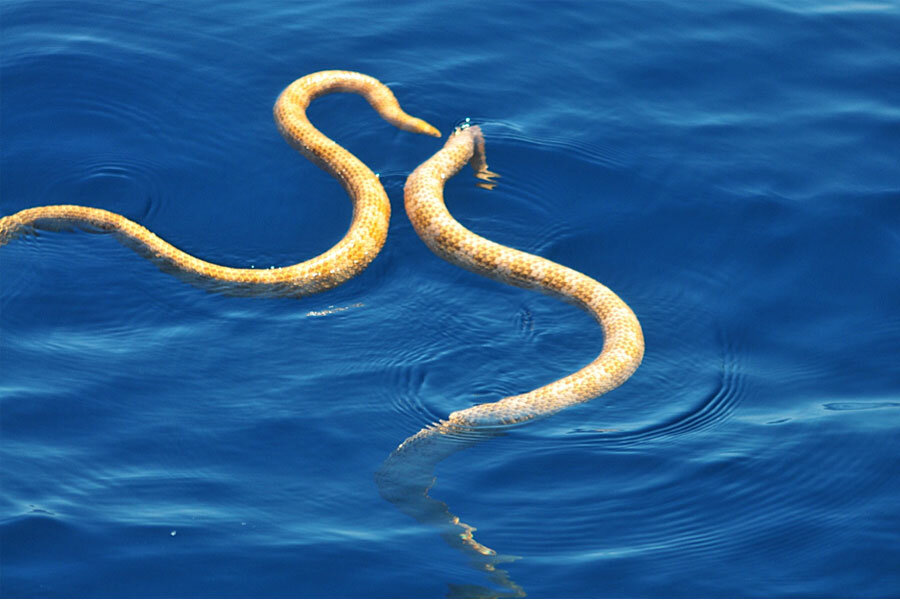'Extinct' sea snakes found alive. A second chance to save them?
Loading...
Researchers have found two different species of sea snake that were previously thought to be extinct.
The snakes, discovered off the coast of Western Australia, had not been seen in more than 15 years.
"This discovery is really exciting, we get another chance to protect these two endemic Western Australian sea snake species," study lead author Blanche D'Anastasi said in a news release.
The two species of sea snake – short nosed and leaf scaled – have disappeared from Ashmore Reef in the Timor Sea, previously their only known habitat. So scientists thought the animals had gone extinct. Instead, it seems they have been driven elsewhere.
The short nose snake was spotted by a Western Australia Parks and Wildlife Officer, Grant Griffin, on Ningaloo Reef.
"We were blown away, these potentially extinct snakes were there in plain sight, living on one of Australia's natural icons, Ningaloo Reef," Ms. D'Anastasi said.
A population of leaf scaled sea snakes was found in the seagrass beds of Shark Bay, over 1,000 miles south of Ashmore Reef.
"We had thought that this species of sea snake was only found on tropical coral reefs. Finding them in seagrass beds at Shark Bay was a real surprise," D'Anastasi said.
The scientists address how the animals' range may have changed and what it might take to save these critically endangered snakes in a paper published Monday in the journal Biological Conservation.
Both snakes are now listed as critically endangered, earning them special protections. But more research still needs to be done, said D'Anastasi.
"In order to succeed in protecting them, we will need to monitor populations as well as undertake research into understanding their biology and the threats they face," she said.
Sea snakes across the board have seen a decline, especially in Ashmore Reef. That reef used to be rich in biodiversity, but only one or two of the nine sea snake species that used to live there still does, according to a 2013 study.
So what is threatening these sea snakes?
"Many of the snakes in this study were collected from prawn trawl by-catch surveys, indicating that these species are vulnerable to trawling," said Vimoksalehi Lukoschek, who also worked on the new paper.
But, the authors write in the paper, "trawling does not occur at the Timor Sea reefs because the reefs descend sharply into very deep waters. Thus the declines of these species could not be attributed to the local impacts of trawling."
The researchers are puzzled. Although finding these animals alive in other locations is good news, the scientists need to know more in order to save them.
"Clearly we need to identify the key threats to their survival in order to implement effective conservation strategies if we are going to protect these newly discovered coastal populations," Dr. Lukoschek said.
These sea snakes aren't the only animals to be rediscovered this year. Animals that were thought to be extinct but were found alive have been hailed as "living fossils."
The Bouvier's red colobus monkey had seemingly disappeared from the wild for decades until this past April. After no sightings since the 1970s, researchers tracked down the primate to prove the species is not extinct.
In August a mollusc called the crusty nautilus was seen again after nearly three decades, leading scientists to call for protection against illegal fishing and "mining" of the animals for nautilus shells.
Scientists have proposed protections that go beyond conservation to save critically endangered animals.
As The Christian Science Monitor's Henry Gass reports:
Some researchers see the next frontier of conservation to be de-extinction. The process has never been successfully completed, but in theory, de-extinction utilizes old DNA to clone an extinct animal back into existence. The idea has been proposed for several lost species, from the passenger pigeon to the wooly mammoth.
But critics abound, especially those who say that funneling resources into de-extinction would divert resources needed to protect current endangered species.
“I don’t think it has any merit at all,” Stuart Pimm, a conservation ecologist at Duke University, told Livescience in 2013. “It totally ignores the very practical realities of what conservation is about.”








